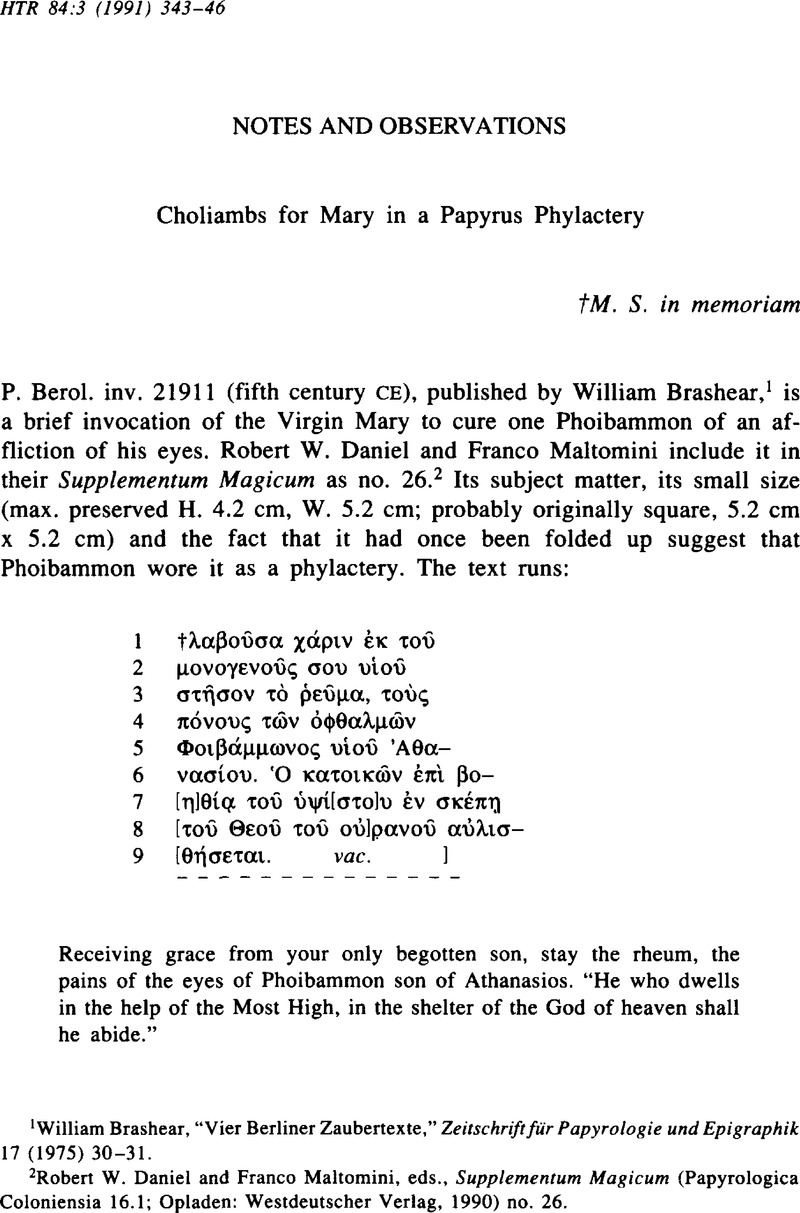No CrossRef data available.
Published online by Cambridge University Press: 10 June 2011

1 Brashear, William, “Vier Berliner Zaubertexte,” Zeitschrift für Papyrologie und Epigraphik 17(1975) 30–31Google Scholar.
2 Daniel, Robert W. and Maltomini, Franco, eds., Supplementum Magicum (Papyrologica Coloniensia 16.1; Opladen: Westdeutscher Verlag, 1990) no. 26Google Scholar.
3 Duling, Dennis C., “Solomon, Exorcism, and the Son of David,” HTR 68 (1975) 239.CrossRefGoogle Scholar
4 Ibid.
5 The fullest list of epigraphical attestations is to be found in Feissel, Denis, “Notes d'épigraphie chrétienne, XXIII. Une inscription de Salamine de Chypre et les citations du psaume 90,” Bulletin de Correspondence Hellénique 108 (1984) 571–79Google Scholar; most examples are from Egypt and Syro-Palestine. For quotations in papyri see the note by Maltomini, at Supplementum Magicum, no. 26, lines 6-8Google Scholar.
6 Delatte, Louis, Un office byzantin d'exorcisme (Ms. de la Lavra du Mont Athos, & 20) (Académie royal de belgique, Mémoires, collection in=80 2d ser., 52; Brussels: Palais des Académies, 1957) 28Google Scholar.
7 Daniel, and Maltomini, , Supplementum Magicum, no. 26, note on line 2Google Scholar.
8 Brashear, , “Vier Berliner Zaubertexte,” 31Google Scholar.
9 Heim, Ricardus, “Incantamenta magica graeca latina,” Jahrbücher für classische Philologie, suppl. ser. 19 (1892) 463–576Google Scholar.
10 Alexander of Tralles Therapeutica in Puschmann, Theodor, ed. and trans., Nachträge zu Alexander Trallianus: Fragmente aus Philumenus und Philagrius (2 vols.; Berlin: n.p., 1886) 2. 585.Google Scholar
11 Here I would mention a line, it too apparently not hitherto recognized as metrical, evidently incised by one person on two virtually identical haematites, one of them in the Cairo Museum (Barry, L., “Notice sur quelques pierres gnostiques,” Annales du Service des Antiquités de l'Égypte 7 [1906] 241–49Google Scholar, no. 3; cf. Delatte, Armand, “Études sur la magie grecque, IV. Amulettes inédites des Musées d'Athénes,” Musée Beige 18 [1914] 80, 82),Google Scholar the other in the collection of D. Brummer (Bonner, Campbell, Studies in Magical Amulets, chiefly Graeco-Egyptian [Ann Arbor, MI: University of Michigan Press, 1950] 86):Google Scholar στάλητι, μήτραμή σε τυΦών καταλάβη. Delatte conjectured that στάλητι might be a miscopying or misunderstanding of a model with στάθητι. If he is right, the text, “Stay (in place), womb, lest Typhon catch you,” is another such “staying” incantation in iambic meter.
12 Ensslin, W., “Phoibammon 4,” PW 39 (1941) 326Google Scholar.